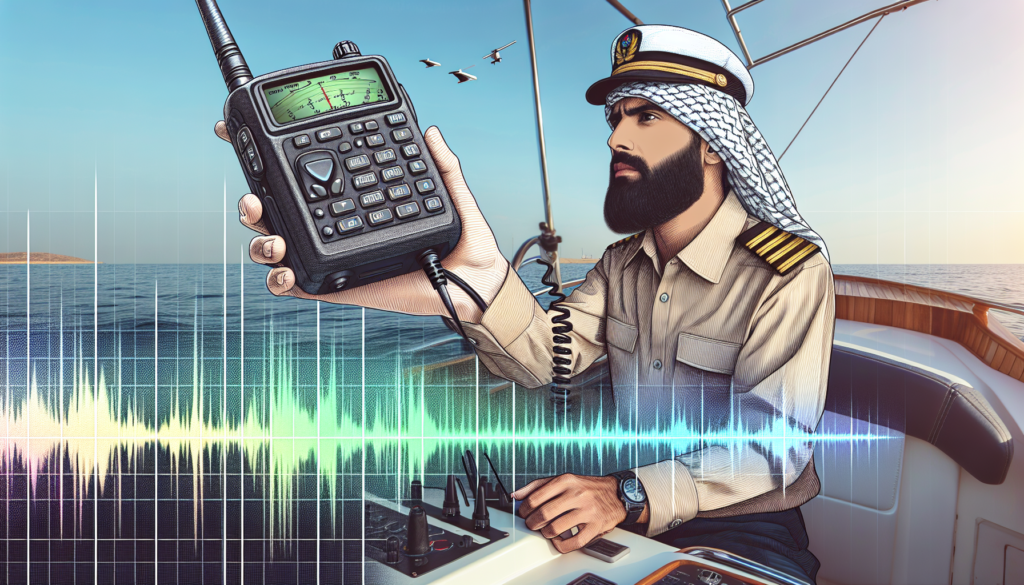Navigating the vast expanses of water aboard a placid vessel or a roaring powerboat, you are the master of your journey. Your proximity to the open skies and expansive waters amplify the sheer exhilaration that accompanies your nautical adventures. However, a pocket of unpredictability always looms, camouflaged by the mirage of endless azure. In your relentless quest for safety, you’ve discovered the vital role of a Very High Frequency (VHF) radio, the reliable partner in your seafaring affairs. “Boating Safety Communication: VHF Radio Guide” gives your curiosity the pedestal it deserves, detailing the nuanced operation of a VHF radio, elucidating its indispensable part in your boating journeys from its operational subtleties to vital importance in emergencies. Armed with this guide, your journey becomes a paradigm of safety, ensuring smooth sailing across the seven seas.

Understanding VHF Radios
Venturing into the world of boating without understanding VHF radios can be likened to entering a labyrinth without a map. These radios aren’t just a fancy amenity, but an essential tool fostering communication safety on the water.
Basics of VHF Radios
VHF, or Very High Frequency radios, come with two main components — the receiver and the transmitter. When you speak into the microphone, your voice is converted into an electronic signal which is then transmitted over a specific channel. The VHF radio, strutting on frequencies ranging between 156 and 174 MHz, operates within a line of sight, which means the signal transmitted can only be received by boats within the horizon.
Role in Boating Safety Communication
VHF radios play a crucial role in boating safety, serving as a lifeline in case of an emergency. They provide flawless maritime communication, allowing you to reach out to the Coast Guard, other boats, or harbors when you most need help. Unlike cellphones that might lose coverage or run out of battery, a VHF radio is a reliable medium to send distress signals or simply communicate with others on the water.
Choosing a VHF Radio
When choosing a VHF radio, it’s essential to consider factors like power output, portability, durability, and built-in features. Depending on your needs, you can opt for a fixed or handheld device. While fixed sets are generally more powerful and have a longer range, handheld devices are portable and can be carried with you at all times.
Working of VHF Radio
How VHF Radio Operates
At its core, a VHF radio operates much like any other radio. You press the talk switch, speak into the microphone, and your sound waves are converted into an electronic signal that is transmitted through your radio’s antenna and sent to radios within your range.
Power and Range of VHF Radios
The power and range of a VHF radio can range from one to 25 watts, with a line-of-sight range of 5 to 60 nautical miles depending on the height and type of your antenna, weather conditions, and other factors.
Channel Specifications
The VHF marine band encompasses channels between 156.050 MHz and 157.425 MHz. Each channel is further designated specific purposes such as coordinating maritime safety information, ship-to-shore communication, or port operations to ensure efficient and clear communication.
Why Use VHF Radio for Boating Communication
Scope of Communication
The VHF radio not only provides communication with the Coast Guard and harbors but also with other boaters in your vicinity which can prove crucial for obtaining local knowledge or assistance in case of any issues.
Reliability in Emergency Situations
The VHF radio is a resilient workhorse. Considering its immunity to network coverage constraints and its sturdy design, the VHF radio stands as the venus flytrap in the jungle of communication devices in any unprecedented maritime incidents.
Advantages Over Other Communication Devices
Unlike cell phones which are subject to signal strength, battery life, and network issues, VHF radios are designed to be always-on, hold a charge for a longer time, and are often water-resistant. They also offer direct communication without the need for intermediaries making it fast and efficient.
Key Features of VHF Radio
Display and Controls
A good VHF radio offers an intuitive and user-friendly interface, with a backlit display for visibility in all lighting conditions and controls that are easy to operate even in rough conditions.
DSC Function
The Digital Selective Calling (DSC) function is a lifesaver when it comes to emitting distress signals. Activating it sends an automatic mayday call, including your boat’s specifics and your location, to all DSC-equipped vessels and rescue coordination centers in range.
GPS Integration
Many VHF radios offer GPS integration, providing you with precise location reading and permitting you to track and communicate your location in case of an emergency or navigation assistance.

Installation of VHF Radio
Selecting the Perfect Location
Select a location with an unobstructed view, easy access, and away from magnetic compasses to prevent interference. Moreover, your location should be chosen considering the length and route of the antenna cable to ensure optimum performance.
Mounting the Radio
Once the location is selected, you can mount the radio using the bracket provided by the manufacturer. Make sure the radio is secured tightly and is easy to access and operate.
Antenna Installation
Your antenna should be installed as high as possible to maximize the range of your VHF radio. It should be free from any obstructions and at a safe distance from metal objects that might interfere with signal transmission.
Wiring and Power Supply
The VHF radio should be wired directly to the boat’s battery using a properly sized wire to prevent voltage drops. Always ensure you have enough power supply for your radio to function correctly.
Using VHF Radio for Distress Calls
Information to Provide
When making distress calls, start by stating “MAYDAY, MAYDAY, MAYDAY,” followed by your vessel’s name or call sign, its precise geographical position, the nature of distress, the number of people on board, and any other relevant information.
Using DSC System for Distress Calls
By pressing the DSC distress button on your VHF radio, you can automatically send out a distress alert with your vessel’s details and location information to all DSC-equipped stations within range. This bypasses the need to verbally transmit a distress call.
Emergency Channels
The VHF radio system has dedicated channels for distress calls. Channel 16 (156.800 MHz) is the international calling and distress channel, while Channel 70 is reserved for digital distress signals using DSC.
Proper Use of VHF Radio
Understanding Radio Etiquette
VHF radio usage requires certain etiquette — keep your communications crisp and meaningful, respect the importance of safety and distress channels, and abstain from using inappropriate language or remarks.
Common VHF Radio Terms
Understanding common radio terms like ‘Roger’ (Understood), ‘Over’ (End of transmission, awaiting response), and ‘Standby’ (Pause for the next communication) is pertinent to effective and efficient maritime communication.
Reserving Channels for Specific Use
Certain channels on the VHF radio band are reserved for specific uses such as distress calls, weather information, or non-commercial communications. It’s important to familiarize yourself with these channel allocations to avoid causing interference or breaking any regulations.
Maintenance and Care of VHF Radio
Regular Cleaning
A little regular cleaning goes a long way in maintaining your VHF radio. Wipe it down with a damp cloth and dry it properly to prevent dust and moisture accumulation.
Battery Care
Battery care is crucial for the sound functioning of your VHF radio. Regularly check and replace the batteries in your handheld device and ensure your fixed radio stays connected to the power source.
Troubleshooting and Repairs
If your VHF radio starts to give you trouble, consult your user manual or trained professionals for troubleshooting advice. Attempting to fix complex problems yourself could potentially cause more damage.
Rules and Regulations Associated with VHF Radio Usage
Licensing Requirements
The Federal Communications Commission (FCC) requires a license to operate a marine VHF radio. This should be prominently displayed onboard and all radio use should adhere to the conditions of the license.
Privacy and Interference Issues
While VHF radio can be a fun and useful tool for communication on the water, remember that any conversations are public and can be heard by all in your range. Avoid sharing private information and deliberately interfering with other conversations.
Penalties for Misuse
Misuse of your VHF radio can result in penalties including fines and withdrawal of licenses. This can include broadcasting false distress signals, inappropriate use of channels, or causing deliberate interference.
Training and courses for VHF Radio Usage
Importance of Training
Knowledge of using a VHF radio correctly is as important as having one. Training courses can give you a comprehensive understanding of radio usage, including handling distress situations, radio etiquette, and regulatory requirements.
Where to Attend Training and Courses
Several maritime associations and institutions offer VHF radio training courses. They can range from online courses to physical classes, allowing you to choose the best learning environment for you.
Gaining Confidence and Competence
Through comprehensive training, you not only gain knowledge on how to use your VHF radio; you also gain confidence. This confidence can be vital during a maritime emergency, allowing you to calmly handle situations and make effective calls for assistance.


[…] systems in boats, namely marine radios, serve as the primary means of communication at sea. They facilitate instant communication with […]
quas distinctio dolorem qui voluptatem deleniti et necessitatibus blanditiis dolorum perspiciatis ut commodi quod amet quasi placeat temporibus. eum pariatur dolorem commodi facere exercitationem quisquam. voluptate quisquam corrupti mollitia veniam quam corporis ut et qui vel velit enim nobis quis suscipit nemo. quis illum dolorem unde earum et tenetur cum qui unde eum qui dolore est aliquid fugiat officiis in optio corrupti. aliquid aperiam ducimus quisquam quis eligendi sint qui explicabo eius molestias nesciunt.